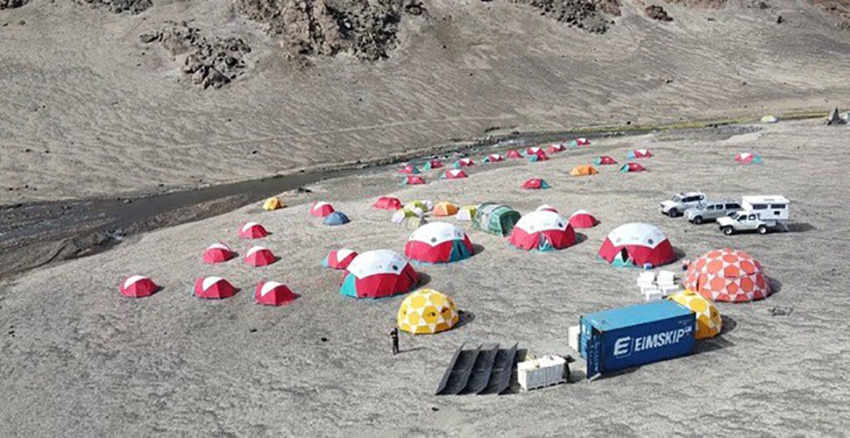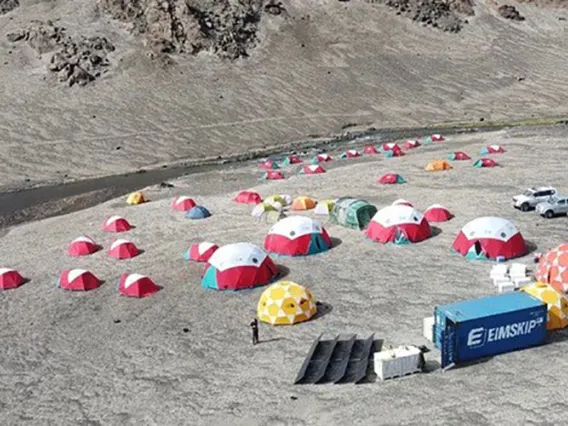
Project RAVEN, Summer 2022
Associate Professor Christopher Hamilton is again in Iceland this summer, leading a team in support of his RAVEN project. RAVEN combines rovers and drones to explore landscapes that may otherwise be inaccessible, such as young volcanic terrains on Mars that are too rough for a rover to traverse.
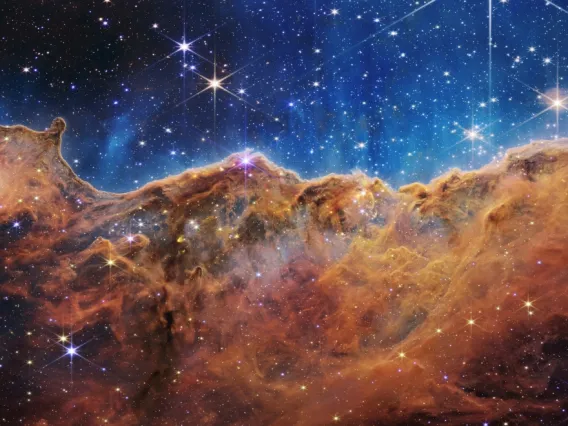
Webb Telescope's Stunning First Images Made Possible by UArizona Instruments and Expertise
The highly anticipated observations mark just the beginning of many years of new science and discovery, and University of Arizona experts are at the helm.
Webb Telescope's Stunning First Images Made Possible by UArizona Instruments and Expertise
×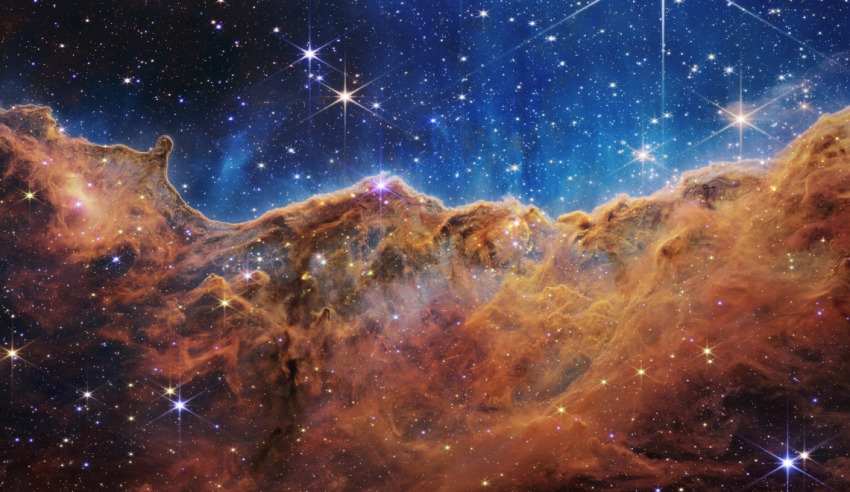
By NASA and University Communications - July 12, 2022
After decades of development, a nail-biting launch and months of space travel and commissioning, NASA has released the first scientific images and spectroscopic data captured by the James Webb Space Telescope. The images hint at the beginning of years of space science, which will in part be made possible by the 21 University of Arizona researchers who have played a role in developing and managing the instruments onboard.
The release of Webb's first images and spectra kicks off the beginning of Webb's science operations, in which astronomers around the world will have their chance to observe anything from objects in our solar system to the early universe, using Webb's four instruments. These include the Near Infrared Camera, or NIRCam, which serves as the telescope's short wavelength imager and is led by principal investigator and UArizona Regents Professor of Astronomy Marcia Rieke. George Rieke, Marcia's husband and also a Regents Professor of Astronomy at UArizona's Steward Observatory, serves as science team lead for the Mid-Infrared Instrument, or MIRI, which will observe the universe at longer wavelengths.
NIRCam and MIRI played a role in creating several of the images released. Since these instruments and the others onboard operate to detect different wavelengths of light, the images can be stacked or compared to learn more about the composition or structure of their targets.
Webb's first observations tell the story of the hidden universe through every phase of cosmic history – from neighboring exoplanets to the most distant observable galaxies in the early universe, and everything in between.
"Today, we present humanity with a groundbreaking new view of the cosmos from the James Webb Space Telescope – a view the world has never seen before," said NASA Administrator Bill Nelson. "These images, including the deepest view of our universe that has ever been taken, show us how Webb will help to uncover the answers to questions we don't even yet know to ask; questions that will help us better understand our universe and humanity's place within it."
The release of the images and spectra reveal the range of capabilities of all four of Webb's state-of-the-art scientific instruments and confirm that future observations will revolutionize our understanding of the cosmos and our own origins.
"Each of Webb's four instruments have capabilities that are aimed at particular science investigations," Marcia Rieke said. "Our NIRCam, for example, was designed to survey large swaths of sky using different filters, while MIRI collects light at longer wavelengths than all other instruments onboard. The Canadian instrument, the Near-Infrared Imager and Slitless Spectrograph, or NIRISS, has special mode for detecting the composition of planets that orbit other stars, and the Near Infrared Spectrograph NIRSpec can take spectra of many objects at once."
The images are all aesthetically appealing, but they also have scientific utility, Marcia Rieke said. These and future images will be mined for answers to particular science questions.
"After years of development and months of commissioning, it's regular operations from here on out," she said.
Marcia Rieke said the questions she's most excited to investigate include how the first galaxies came together to create something like our own Milky Way and if we can find an exoplanet with an Earthlike atmosphere.
George Rieke said some of the objects he's most excited to study with the powerful MIRI instrument are quasars, which are supermassive black holes at the center of galaxies that create bright jets of light as they consume the surrounding gas.
"MIRI and all of Webb's other instruments are ushering humanity into new scientific territory and that's super exciting," he said.
Webb's first observations were selected by a group of representatives from NASA, the European Space Agency, Canadian Space Agency and the Space Telescope Science Institute, who are all partners on the project:
- Carina Nebula: Looking at this star-forming region and others like it, with Webb, scientists can see newly forming stars and study the gas and dust that made them.
- Southern Ring planetary nebula: From birth to magnificent death as a planetary nebula, Webb can explore the expelling shells of dust and gas of aging stars that may one day become a new star or planet.
- Stephan's Quintet galaxies: Stars derive from, and contribute to, gas and dust in mass quantities, swirling around galaxies. Webb can study nearby and dynamic interacting galaxies to see the gas and dust in action. Now, scientists can get a rare look, in unprecedented detail, at how interacting galaxies are triggering star formation in each other and how the gas in these galaxies is being disturbed.
- SMACS 0723 deep field view: To truly understand our beginnings, we must trace these galaxies back to the beginning. This deep field uses a lensing galaxy cluster to find some of the most distant galaxies ever detected. This image is only scratching the surface of Webb's capabilities in studying deep fields.
- WASP-96b exoplanet: Studying other planetary systems like this will help astronomers find out how typical, or atypical, our solar system is. Webb has detected water molecules on an exoplanet and will now set out to study hundreds of other systems to understand what other planetary atmospheres are made of.
"I'm very happy for all the young scientists who staked their early careers on Webb working smoothly and poured their hearts into getting every aspect tested and documented, and then turned it over to the astronomical community to let everyone help rewrite all the textbooks with new discoveries," George Rieke said.
The James Webb Space Telescope launched Dec. 25, 2021, on an Ariane 5 rocket from Europe's Spaceport in French Guiana. After completing the most complex and difficult deployment sequence in space, Webb underwent months of commissioning, in which its mirrors were painstakingly aligned, and its instruments were calibrated to its space environment and prepared for science.
NASA Headquarters oversees the mission for the agency's Science Mission Directorate. NASA's Goddard Space Flight Center in Greenbelt, Maryland, manages Webb for the agency and oversees work on the mission performed by the Space Telescope Science Institute, Northrop Grumman and other mission partners. In addition to Goddard, several NASA centers contributed to the project, including the agency's Johnson Space Center in Houston, Jet Propulsion Laboratory in Southern California, Marshall Space Flight Center in Huntsville, Alabama, Ames Research Center in California's Silicon Valley and others.
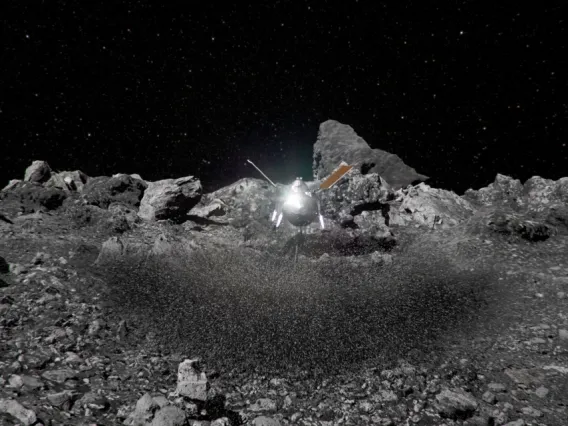
OSIRIS-REx Scientists: Taking Asteroid Sample Was Like Punching a Ball Pit
Before-and-after images and measurements revealed a treasure trove of data from the few seconds that it took for the OSIRIS-REx spacecraft to collect an asteroid sample, which is currently en route to Earth.
OSIRIS-REx Scientists: Taking Asteroid Sample Was Like Punching a Ball Pit
×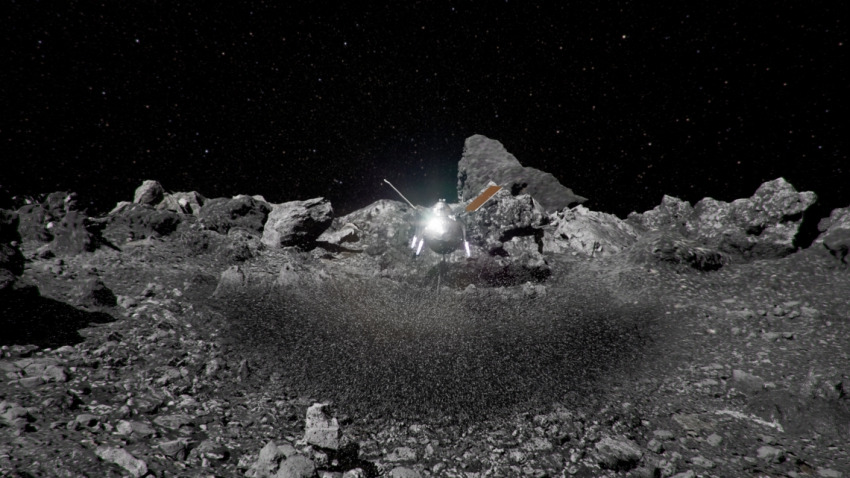
By Daniel Stolte/UANews and Lonnie Shekhtman/NASA - July 7, 2022
Asteroid Bennu, the target of NASA's OSIRIS-REx asteroid sample return mission, led by the University of Arizona, kept surprising the mission team while the spacecraft studied the asteroid from a distance. The biggest surprise, however, came when OSIRIS-REx swooped in to grab a sample of material from Bennu and encountered not a solid surface but one that gave way so easily the sampler arm sank 1 1/2 feet into it within seconds.
The OSIRIS-REx mission team has spent the time since the sample collection in 2020 processing data recorded by the spacecraft's instruments during and after the sampling event. Taking advantage of top-notch science instruments – some built at the University of Arizona – along with clever spacecraft maneuvering and detailed observations of individual rocks, the team uncovered a treasure trove of information about what Bennu and other asteroids similar to it are actually like.
Two papers in the journals Science and Science Advances detail the latest findings about Bennu's physical properties and provide a fascinating account of the events surrounding the sampling event. One paper was led by UArizona Regents Professor of Planetary Sciences Dante Lauretta, the mission's principal investigator, and the other was led by Kevin Walsh, a member of the OSIRIS-REx science team with Southwest Research Institute in Boulder, Colorado.
When the OSIRIS-REx spacecraft descended to the surface of Bennu on Oct. 20, 2020 – its sampling arm extended in anticipation of scooping up pristine material dating back to the formation of our solar system – mission scientists and engineers braced for an experience resembling a pogo stick bouncing off a gravel road. To everybody's surprise, that didn't happen. Instead, once the sampling head made contact with the surface, it dove right in with almost no resistance.
One of the most surprising takeaways is this: Had the spacecraft not fired its thrusters to back away immediately after grabbing dust and rock from the asteroid's surface, it would have sunk right into Bennu, and the asteroid might have swallowed it whole.
"It turns out that the particles making up Bennu's exterior are so loosely packed and lightly bound to each other that they act more like a fluid than a solid," Lauretta said.
In other words, if a person were to step onto Bennu, they would feel very little resistance, as if stepping into a pit of plastic balls that are popular play areas for kids.
The results add to the intrigue that's kept scientists on the edge of their seats throughout NASA's OSIRIS-REx sample-return mission, as Bennu has proved consistently unpredictable.
The asteroid presented its first surprise in December 2018 when NASA's spacecraft arrived to survey it. The OSIRIS-REx team found a surface littered with boulders instead of the smooth, sandy beach they expected based on observations from Earth- and space-based telescopes. Scientists also discovered that Bennu was spitting particles of rock into space.
"Our expectations about the asteroid's surface were completely wrong," Lauretta said. "There was no obvious place to collect a sample anywhere."
The latest hint that Bennu was not what it seemed came after the OSIRIS-REx spacecraft picked up a sample and beamed down stunning, close-up images of the asteroid's surface to Earth.
"What we saw was a huge wall of debris radiating out from the sample site," Lauretta said. "We were like, 'Holy cow!'"
Scientists were bewildered by the abundance of pebbles strewn about, given how gently the spacecraft tapped the surface. Even more bizarre was that the spacecraft left a large crater, 26 feet wide.
"Every time we tested the sample pickup procedure in the lab, we barely made a divot," Lauretta said. As a result of the surprises found in the images, Lauretta and his team decided to send the spacecraft back to take more photographs of Bennu's surface "to see how big of a mess we made."
The imagers of the OSIRIS-REx Camera Suite, or OCAMS, provided the researchers with high-resolution, fast-sequence snapshots of the sample site before, during and after the sample acquisition. Additionally, the spacecraft collected data with the Touch-and-Go Camera System, or TAGCAMS, which is part of its guidance, navigation and control system. Using image processing algorithms, the researchers were able to tease an amazing amount of information from the pictures taken by the spacecraft, allowing for realistic calculations of the amount of material that was kicked up by the spacecraft plunging into the surface and detailed clues about how dust, pebbles and even boulders move and behave in Bennu's microgravity environment.
Besides analyzing the volume of debris visible in before-and-after images of the sample site, dubbed "Nightingale," the mission team also looked at acceleration data collected during the spacecraft's touch-and-go sample collection maneuver. This data revealed that as OSIRIS-REx touched the asteroid it experienced the same amount of resistance – very little – that a person would feel while squeezing the plunger on a French press coffee carafe.
"By the time we fired our thrusters to leave the surface we were still plunging into the asteroid," said Ron Ballouz, a former LPL postdoctoral researcher at UArizona’s Lunar and Planetary Laboratory who is now based at the Johns Hopkins Applied Physics Laboratory in Laurel, Maryland.
Ballouz and the research team ran hundreds of computer simulations to deduce Bennu's density and cohesion based on spacecraft images and acceleration information. Engineers varied the surface cohesion properties in each simulation until they found the one that most closely matched their real-life data.
Spectral analysis of light reflected from the sample site before and after the sampling revealed that the process exposed and mobilized fine dust from a few inches below the surface, reminiscent of a condition on Earth known as desert pavement, which forms when fine dust is being blown and washed away by wind and rainfall, leaving behind a relatively stable surface of similar-sized pebbles and rocks.
"Our observations confirm previous results, which have found that the most freshly exposed surfaces are among the spectrally reddest and darkest," Lauretta said. "We attribute the spectral changes to the exposure of fresh, organic-rich material, which is exactly the type of material we were hoping to get in our sample, so we can analyze it once it returns to Earth."
Now, this precise information about Bennu’s surface can help scientists better interpret remote observations of other asteroids, which could be useful in designing future asteroid missions and for developing methods to protect Earth from asteroid collisions.
It's possible that asteroids like Bennu — barely held together by gravity or electrostatic force — could break apart in Earth's atmosphere and thus pose a different type of hazard than solid asteroids.
The University of Arizona leads the OSIRIS-REx science team and the mission's science observation planning and data processing. NASA's Goddard Space Flight Center in Greenbelt, Maryland, provides overall mission management, systems engineering, and the safety and mission assurance for OSIRIS-REx. Lockheed Martin Space in Littleton, Colorado, built the spacecraft and provides flight operations. Goddard and KinetX Aerospace are responsible for navigating the OSIRIS-REx spacecraft. OSIRIS-REx is the third mission in NASA's New Frontiers Program, managed by NASA's Marshall Space Flight Center in Huntsville, Alabama, for the agency's Science Mission Directorate Washington, D.C.
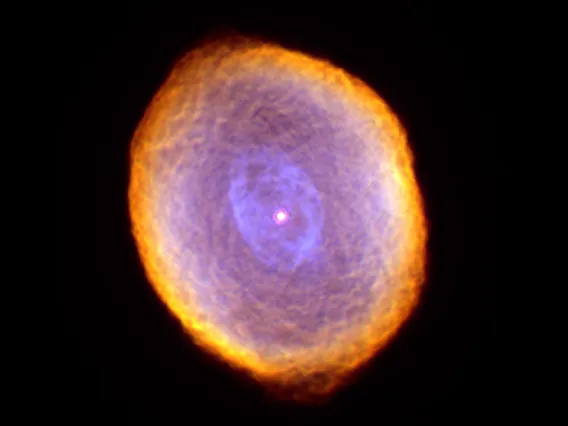
Dying stars could seed interstellar medium with carbon nanotubes
Evidence suggests that carbon nanotubes, tiny tubes consisting of pure carbon, could be forged in the envelopes of dust and gas surrounding dying stars. The findings propose a simple, yet elegant mechanism for the formation and survival of complex carbon molecules in space.
Dying stars could seed interstellar medium with carbon nanotubes
×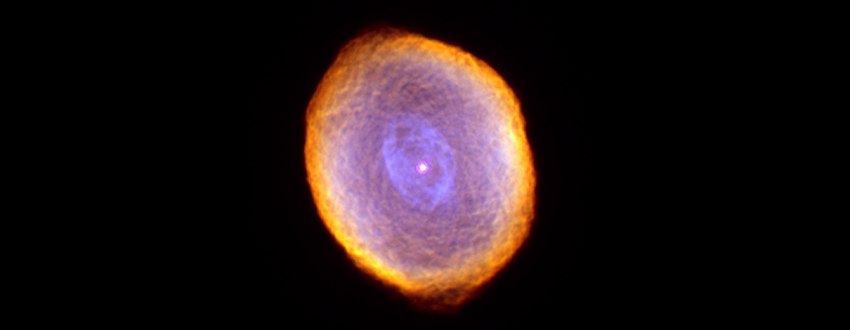
In the mid-1980s, the discovery of complex carbon molecules drifting through the interstellar medium garnered significant attention, with possibly the most famous examples being Buckminsterfullerene, or "buckyballs" – spheres consisting of 60 or 70 carbon atoms. However, scientists have struggled to understand how these molecules can form in space.
In a paper accepted for publication in the Journal of Physical Chemistry A, researchers from the University of Arizona suggest a surprisingly simple explanation. After exposing silicon carbide – a common ingredient of dust grains in planetary nebulae – to conditions similar to those found around dying stars, the researchers observed the spontaneous formation of carbon nanotubes, which are highly structured rod-like molecules consisting of multiple layers of carbon sheets. The findings were presented on June 16 at the 240th Meeting of the American Astronomical Society in Pasadena, California.
Led by UArizona researcher Jacob Bernal, the work builds on research published in 2019, when the group showed that they could create buckyballs using the same experimental setup. The work suggests that buckyballs and carbon nanotubes could form when the silicon carbide dust made by dying stars is hit by high temperatures, shock waves and high-energy particles, leaching silicon from the surface and leaving carbon behind.
The findings support the idea that dying stars may seed the interstellar medium with nanotubes and possibly other complex carbon molecules. The results have implications for astrobiology, as they provide a mechanism for concentrating carbon that could then be transported to planetary systems.
"We know from infrared observations that buckyballs populate the interstellar medium," said Bernal, a postdoctoral research associate in the UArizona Lunar and Planetary Laboratory. "The big problem has been explaining how these massive, complex carbon molecules could possibly form in an environment saturated with hydrogen, which is what you typically have around a dying star."
In this schematic illustration, experimental heating causes a grain of silicon carbide to shed silicon atoms (green). This leaves behind carbon atoms (black), which assemble into sheets of graphene and ultimately into rod-shaped carbon nanotubes and spherical buckyballs.Jacob Bernal/University of Arizona
The formation of carbon-rich molecules, let alone species containing purely carbon, in the presence of hydrogen is virtually impossible due to thermodynamic laws. The new study findings offer an alternative scenario: Instead of assembling individual carbon atoms, buckyballs and nanotubes could result from simply rearranging the structure of graphene – single-layered carbon sheets that are known to form on the surface of heated silicon carbide grains.
This is exactly what Bernal and his co-authors observed when they heated commercially available silicon carbide samples to temperatures occurring in dying or dead stars and imaged them. As the temperature approached 1,050 degrees Celsius, small hemispherical structures with the approximate size of about 1 nanometer were observed at the grain surface. Within minutes of continued heating, the spherical buds began to grow into rod-like structures, containing several graphene layers with curvature and dimensions indicating a tubular form. The resulting nanotubules ranged from about 3 to 4 nanometers in length and width, larger than buckyballs. The largest imaged specimens were comprised of more than four layers of graphitic carbon. During the heating experiment, the tubes were observed to wiggle before budding off the surface and getting sucked into the vacuum surrounding the sample.
"We were surprised we could make these extraordinary structures," Bernal said. "Chemically, our nanotubes are very simple, but they are extremely beautiful."
Named after their resemblance to architectural works by Richard Buckminster Fuller, fullerenes are the largest molecules currently known to occur in interstellar space, which for decades was believed to be devoid of any molecules containing more than a few atoms, 10 at most. It is now well established that the fullerenes C60 and C70, which contain 60 or 70 carbon atoms, respectively, are common ingredients of the interstellar medium.
One of the first of its kind in the world, the transmission electron microscope housed at the Kuiper Materials Imaging and Characterization Facility at UArizona is uniquely suited to simulate the planetary nebula environment. Its 200,000-volt electron beam can probe matter down to 78 picometers – the distance of two hydrogen atoms in a water molecule – making it possible to see individual atoms. The instrument operates in a vacuum closely resembling the pressure – or lack thereof – thought to exist in circumstellar environments.
While a spherical C60 molecule measures 0.7 nanometers in diameter, the nanotube structures formed in this experiment measured several times the size of C60, easily exceeding 1,000 carbon atoms. The study authors are confident their experiments accurately replicated the temperature and density conditions that would be expected in a planetary nebula, said co-author Lucy Ziurys, a UArizona Regents Professor of Astronomy, Chemistry and Biochemistry.
"We know the raw material is there, and we know the conditions are very close to what you'd see near the envelope of a dying star," she said. "There are shock waves that pass through the envelope, so the temperature and pressure conditions have been shown to exist in space. We also see buckyballs in these planetary nebulae – in other words, we see the beginning and the end products you would expect in our experiments."
These experimental simulations suggest that carbon nanotubes, along with the smaller fullerenes, are subsequently injected into the interstellar medium. Carbon nanotubes are known to have high stability against radiation, and fullerenes are able to survive for millions of years when adequately shielded from high-energy cosmic radiation. Carbon-rich meteorites, such as carbonaceous chondrites, could contain these structures as well, the researchers propose.
According to study co-author Tom Zega, a professor in the UArizona Lunar and Planetary Lab, the challenge is finding nanotubes in these meteorites, because of the very small grain sizes and because the meteorites are a complex mix of organic and inorganic materials, some with sizes similar to those of nanotubes.
"Nonetheless, our experiments suggest that such materials could have formed in interstellar space," Zega said. "If they survived the journey to our local part of the galaxy where our solar system formed some 4.5 billion years ago, then they could be preserved inside of the material that was left over."
Zega said a prime example of such leftover material is Bennu, a carbonaceous near-Earth asteroid from which NASA's UArizona-led OSIRIS-REx mission scooped up a sample in October 2020. Scientists are eagerly awaiting the arrival of that sample, scheduled for 2023.
"Asteroid Bennu could have preserved these materials, so it is possible we may find nanotubes in them," Zega said.
Funding for this work was provided by NSF Grant AST-2137919, NSF Grant AST-1907910, and NASA grants 80NSSC19K0509 and 80NSSC21K0593 ("Alien Earths"). Bernal was granted a Mathematical and Physical Sciences Ascend Fellowship by the National Science Foundation.

How to Spot Asteroids
“Stay up all night,” says Gregory Leonard, a research scientist at the University of Arizona’s Catalina Sky Survey, who uses a network of powerful telescopes to find and track what NASA calls near-Earth objects, including asteroids that come within 120 million miles of the sun. Go looking in a place without light pollution on a cloudless night with a steady atmosphere. Avoid a full moon.
How to Spot Asteroids
×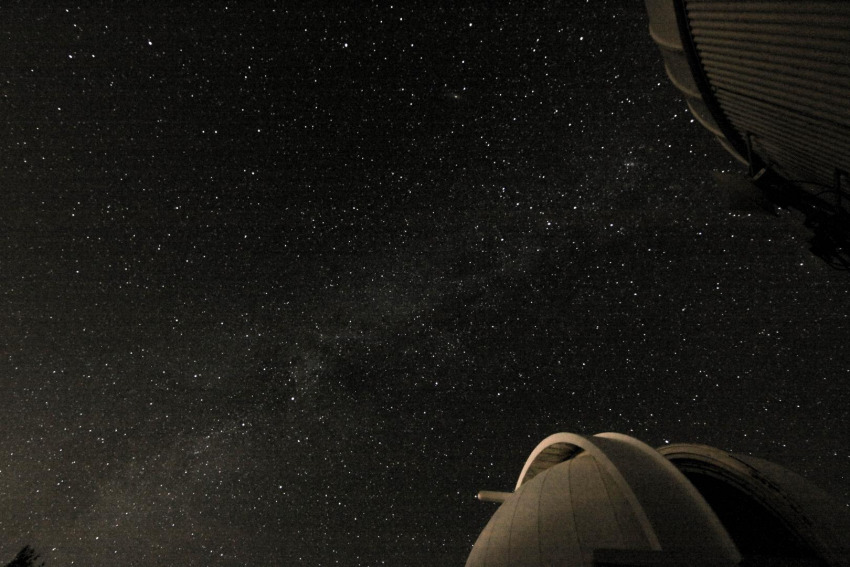
By Malia Wollan - March 15, 2022
“Stay up all night,” says Gregory Leonard, a research scientist at the University of Arizona’s Catalina Sky Survey, who uses a network of powerful telescopes to find and track what NASA calls near-Earth objects, including asteroids that come within 120 million miles of the sun. An amateur hunter can use the same strategies as a professional. Go looking in a place without light pollution on a cloudless night with a steady atmosphere (if you see stars sparkling, it’s a sign of atmospheric turbulence). Avoid a full moon. Leonard and his asteroid-hunter colleagues tend to be solitary types who don’t mind working solo night shifts and sleeping during the day.
Under the darkest skies, you might see Vesta, the largest asteroid, with your naked eye. Discovering others will require a telescope, preferably one with an aperture of at least eight inches and equipped with an astronomy-imaging camera. Take multiple photographs of a patch of sky over 60 minutes and then quickly flip through those images one after the other, looking for bits of light in motion. Stars will appear stationary, but asteroids, satellites, comets and other bits of space debris will seem to move. Try to photograph your asteroid over several nights to collect information on its orbital path.
If you think you’ve seen an asteroid, submit your data to the Minor Planet Center, funded by NASA and run by Harvard and the Smithsonian. The center has received some 340 million observations, including more than 28,500 near-Earth object discoveries, all available to the public.
On any given night, alone at a survey telescope in the Santa Catalina Mountains north of Tucson, Leonard says he feels “a little bit like a lighthouse keeper,” looking for potential danger out in the cosmic sea. Do not go hunting for chunks of rock hurtling through space unless you can do so without feeling overwhelmed by fear. If you’re going to worry, do it in a gentle way with a deep-time mind-set. “The probability of being affected by an impacting asteroid in a human lifetime is about as close to zero as one can get,” Leonard says. “That said, over geologic time, the probability is 100 percent that there’s an asteroid that’s got our number on it.”

Dr. Sarah Moran Named UArizona Sursum Fellow
Dr. Moran was selected for her proposal on Haze Evolution in sub-Neptune Exoplanets through UV Laboratory Experiments.

Dr. Sukrit Ranjan Joins LPL Faculty Starting Fall 2022
Sukrit's work is focused on the origin of life on Earth, the search for life on other worlds, and the atmospheres of rocky exoplanets. He applies photochemistry to questions related to the origin of life on Earth and the search for life on other worlds.Dr. Sukrit Ranjan Joins LPL Faculty Starting Fall 2022
×
Dr. Sukrit Ranjan will join LPL as an assistant professor. Sukrit completed his Ph.D. in Astronomy and Astrophysics at Harvard University, where he was the first student to earn a certificate in Origin of Life studies. Sukrit completed his undergraduate work at MIT, majoring in physics and minoring in astronomy and history. In addition to research, Dr. Ranjan values outreach and education.
Sukrit works to constrain the palette of environmental conditions from which life arose on Earth to constrain and guide experimental studies of the origin of life. To search for life elsewhere, he works to determine observational tests by which life on other worlds may be remotely discriminated. In collaboration with experimental colleagues, Sukrit seeks to obtain the critical measurements of fundamental photochemical parameters required to build robust models in support of both goals.

Dr. Kathryn Volk, Vera Rubin Early Career Prize Winner
LPL Research Scientist Dr. Kathryn Volk has been named the recipient of the Vera Rubin Early Career Prize, which recognizes an early career dynamicist who demonstrates excellence in scientific research in dynamical astronomy. Dr. Volk received her Ph.D. from LPL in 2013.
Dr. Kathryn Volk, Vera Rubin Early Career Prize Winner
×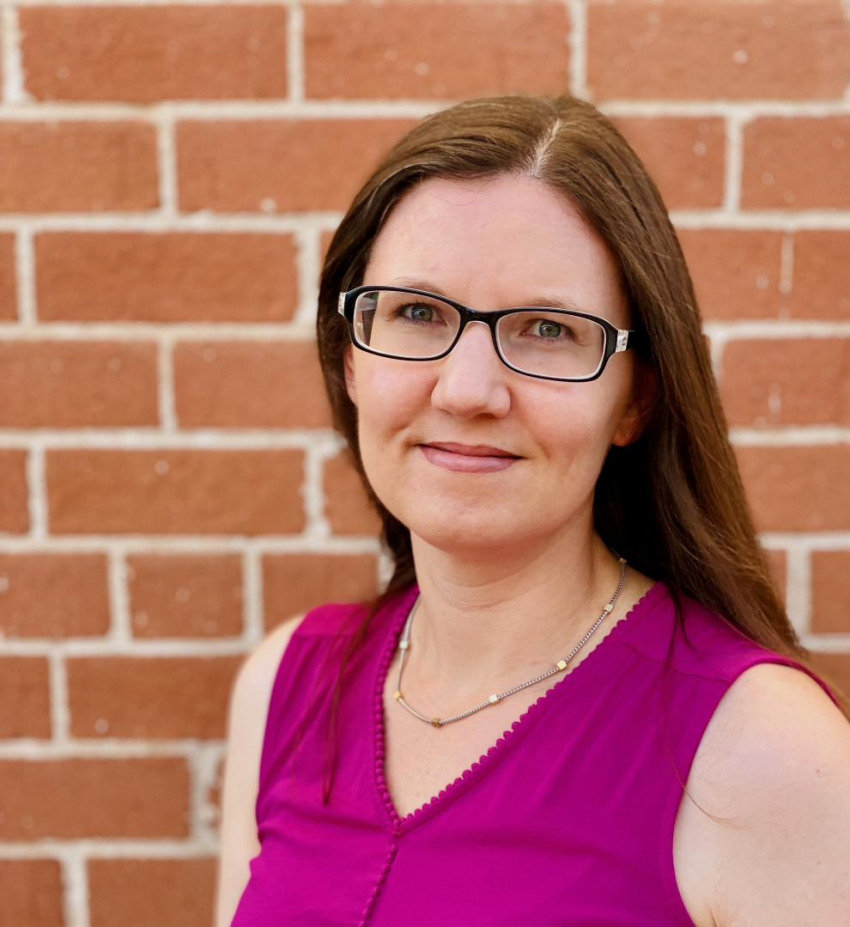
The American Astronomical Society’s Division on Dynamical Astronomy (DDA) is pleased to announce that the 2022 recipient of the Vera Rubin Early Career Award is Dr. Kathryn Volk of the University of Arizona, for her work on both the dynamics of small bodies beyond Neptune, and the long-term dynamics and stability of tightly packed exoplanetary systems.
Dr. Volk earned her Ph.D. from the University of Arizona in 2013 under the direction of Prof. Renu Malhotra, then held a postdoctoral fellowship at the University of British Columbia before returning to the University of Arizona, first as a postdoctoral associate and later as an Associate Staff Scientist. Her numerous contributions span both Solar System and exoplanetary science, powerfully bringing together theory, numerics and observation.
Orbital migration of the giant planets early in the Solar System’s history can explain various small-body populations in the outer Solar System. In particular, groups of trans-Neptunian objects (TNOs) captured into different mean motion resonances with Neptune are natural consequences of the latter migrating outward, and close encounters with Neptune are thought to be responsible for the dynamically excited scattered disk. Dr. Volk has made fundamental contributions both to the observational characterization of these small-body populations through her core role in the Outer Solar System Origins Survey, as well as to rigorously confronting this theoretical picture of the early Solar System against observations through her extensive numerical investigations. Her work has been influential in quantifying the rates at which Jupiter-family comets are generated from their hypothesized source in the scattered disk beyond Neptune, and in characterizing the underlying resonant TNO populations as observational anchors for theories of the early Solar System.
Dr. Volk has also significantly shaped the field of exoplanetary science. Her proposal that most planetary systems begin in compact configurations, which continually destabilize and rearrange throughout their lifetimes, has been highly influential, and she has made fundamental contributions to our understanding of the long-term dynamical stability of exoplanetary systems. In particular, her work demonstrates that the future lifetimes of mature exoplanet systems are set by slow chaotic diffusion induced by the overlap of secular (rather than mean-motion) resonances.
Finally, Dr. Volk has made central and persistent contributions to the division itself. Her leadership as Vice-Chair and then Chair of the DDA was instrumental through the COVID-19 pandemic. She was the principal force behind the restructuring and organization of the highly successful 2020 and 2021 meetings in a virtual format, not only maintaining the operations of the division, but also managing to grow and diversify the membership in the process.
Dr. Volk will be invited to give a lecture at the 54th annual DDA meeting in the spring of 2023.

NASA Gives Green Light for OSIRIS-REx Spacecraft to Visit Another Asteroid
The extended mission, dubbed OSIRIS-APEX, will study the near-Earth asteroid Apophis, which will have a close encounter with Earth in 2029.
NASA Gives Green Light for OSIRIS-REx Spacecraft to Visit Another Asteroid
×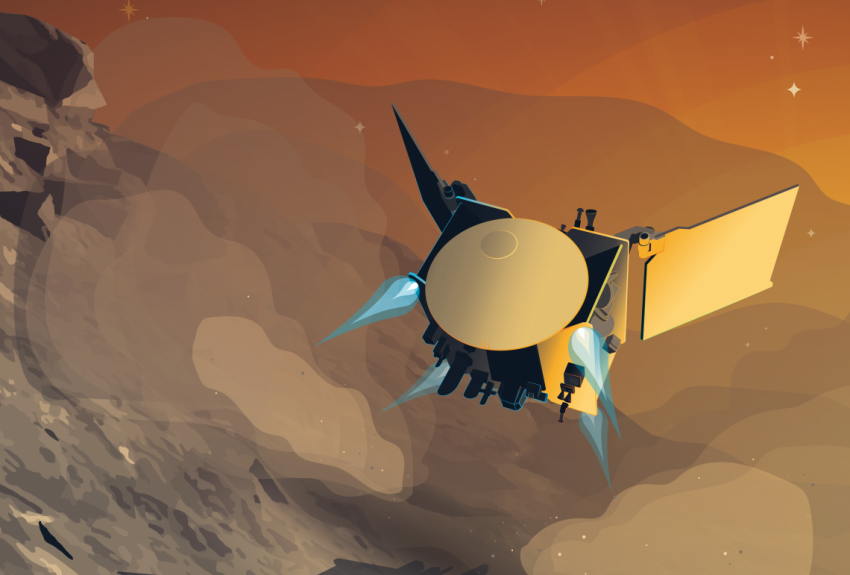
By Mikayla Mace Kelley, University Communications - April 25, 2022
NASA's OSIRIS-REx spacecraft will swing by Earth to deliver a sample from asteroid Bennu on Sept. 24, 2023. But it won't clock out after that.
NASA has extended the University of Arizona-led mission, which will be renamed OSIRIS-APEX, to study near-Earth asteroid Apophis for 18 months. Apophis will make a close approach to Earth in 2029.
The University of Arizona will lead the mission, which will make its first maneuver toward Apophis 30 days after the OSIRIS-REx spacecraft delivers the sample it collected from Bennu back in October 2020. At that point, the original mission team will split – the sample analysis team will analyze the Bennu sample, while the spacecraft and instrument team transitions to OSIRIS-APEX, which is short for OSIRIS-Apophis Explorer.
Regents Professor of Planetary Sciences Dante Lauretta will remain principal investigator of OSIRIS-REx through the remaining two-year sample return phase of the mission. Planetary sciences assistant professor and OSIRIS-REx deputy principal investigator Dani DellaGiustina will then become principal investigator of OSIRIS-APEX. The extension adds another $200 million to the mission cost cap.
The mission team did an exhaustive search for potential asteroid targets. The OSIRIS-REx spacecraft was built for what's called a rendezvous mission, meaning instead of making a single flyby of an object and quickly snapping images and collecting data, it was designed to "get up close and personal with the object." DellaGiustina said. "Our spacecraft is really phenomenal at that."
"Apophis is one of the most infamous asteroids," DellaGiustina said. "When it was first discovered in 2004, there was concern that it would impact the Earth in 2029 during its close approach. That risk was retired after subsequent observations, but it will be the closest an asteroid of this size has gotten in the 50 or so years asteroids have been closely tracked, or for the next 100 years of asteroids we have discovered so far. It gets within one-tenth the distance between the Earth and moon during the 2029 encounter. People in Europe and Africa will be able to see it with the naked eye, that's how close it will get. We were stoked to find out the mission was extended."
OSIRIS-REx was launched in 2016 to collect a sample from Bennu that will help scientists learn about the formation of the solar system and Earth as a habitable planet. OSIRIS-REx is the first NASA mission to collect and return a sample from a near-Earth asteroid.
OSIRIS-APEX will not collect a sample, but when it reaches Apophis, it will study the asteroid for 18 months and collect data along the way. It also will make a maneuver similar to the one it made during sample collection at Bennu, by approaching the surface and firing its thrusters. This event will expose the asteroid's subsurface, to allow mission scientists to learn more about the asteroid's material properties.
The scientists also want to study how the asteroid will be physically affected by the gravitational pull of Earth as it makes its close approach in 2029.
They also want to learn more about the composition of the asteroid. Apophis is about the same size as Bennu – nearly 1000 feet at its longest point – but it differs in what's called its spectral type. Bennu is a B-type asteroid linked to carbonaceous chondrite meteorites, whereas Apophis is an S-type asteroid linked to ordinary chondrite meteorites.
"The OSIRIS-REx mission has already achieved so many firsts and I am proud it will continue to teach us about the origins of our solar system," said University of Arizona President Robert C. Robbins. "The OSIRIS-APEX mission extension keeps the University of Arizona in the lead as one of the premier institutions in the world to study small bodies with spacecraft and demonstrates again our incredible capacity in space sciences."
DellaGiustina is also excited that the mission provides an excellent opportunity for early career scientists to gain professional development. OSIRIS-REx veterans will work closely with these early career scientists as mentors in the early mission phases. By the time the spacecraft arrives at Apophis, the next generation will step into leadership roles on OSIRIS-APEX.
"OSIRIS-APEX is a manifestation of a core objective of our mission to enable the next generation of leadership in space exploration. I couldn't be prouder of Dani and the APEX team," Lauretta said. "Dani first started working with us in 2005 as an undergraduate student. To see her take on the leadership of the mission to asteroid Apophis demonstrates the outstanding educational opportunities at the University of Arizona."
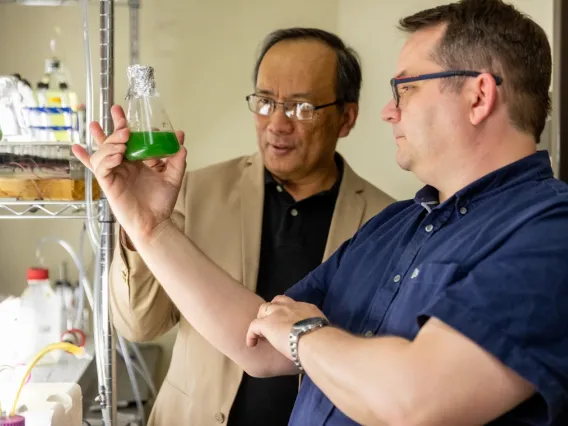
Small but Mighty: How UArizona Professors are Harnessing the Power of Algae to Capture Carbon
An astrobiologist, an engineer and an ecologist have teamed up to mitigate the worst effects of climate change.
Small but Mighty: How UArizona Professors are Harnessing the Power of Algae to Capture Carbon
×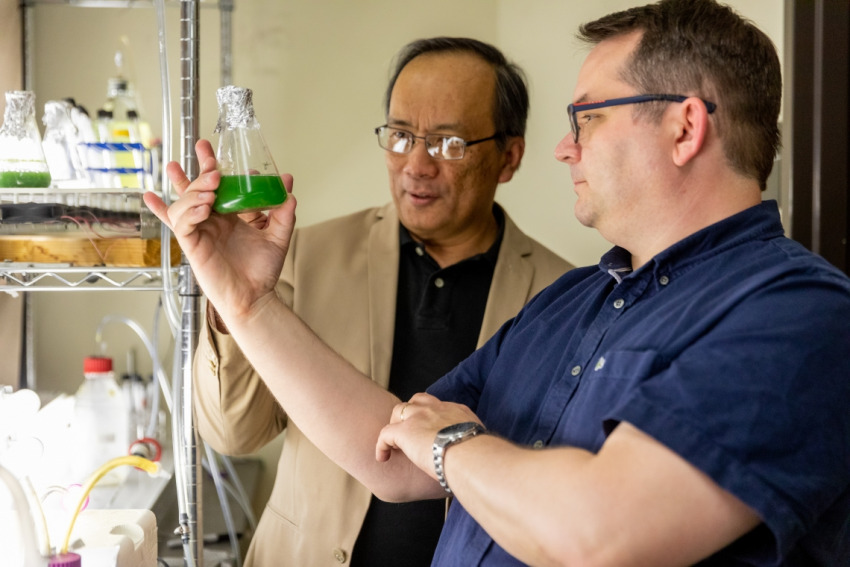
By Mikayla Mace Kelley, University Communications - April 20, 2022
As a University of Arizona professor of astronomy and planetary sciences who studies planets orbiting other stars, Daniel Apai spends much of his time thinking about what makes worlds habitable.
On Earth, the carbon cycle plays a key role in maintaining conditions for life. Earth releases carbon into the atmosphere and reabsorbs it through geological and biological processes. But humans have released more carbon dioxide into the atmosphere than the carbon cycle naturally would, causing global temperatures to rise.
Apai has assembled a team that plans to harness the principles of the carbon cycle to trap massive amounts of carbon dioxide and curb the worst impacts of climate change.
They call themselves Atmospherica. In addition to Apai, the team includes Joel Cuello, a professor of agricultural and biosystems engineering and BIO5 Institute member; Régis Ferrière, an associate professor of ecology and evolutionary biology; Martin Schlecker, an astrophysicist and postdoctoral research associate; and Jack Welchert, a biosystems engineering doctoral student.
Reports from the Intergovernmental Panel on Climate Change and future climate projections find that preventing the worst effects of climate change will require carbon removal from the atmosphere at gigaton-per-year levels.
"Yet, no existing technology is thought to be scalable enough to succeed in this," Apai said. "What we need to do as a civilization is to reduce our emissions as much as possible, because extracting from the air is much more difficult than not emitting it. No one has come up with a solution that extracts carbon dioxide so efficiently as to allow the continued burning of fossil fuels."
The Atmospherica team team hopes to be a part of the solution, by harnessing the power of algae.
It's all in the algae
"Climate change is one of the great challenges we are facing as a species and civilization," Apai said.
He began the search for potential climate change solutions as a hobby seven years ago. He found that most existing carbon removal solutions could not be scaled up to the levels required, were prohibitively expensive or were harmful to the environment.
As an astrobiologist, he decided to pursue solutions inspired by nature. That's when he learned about coccolithophores – single-celled marine algae. What makes these algae special is the fact that they use atmospheric carbon dioxide and calcium from saltwater to create intricate shells made of calcium carbonate – a very stable, chalk-like mineral. These shells evolved to protect the algae and regulate the algae's buoyancy and light exposure.
Coccolithophores naturally extract carbon dioxide from the ocean as part of their life cycle. While most of them are consumed by predators, a very small fraction decompose, uneaten, while their carbon-containing shells sink to the ocean floor, where they remain indefinitely. The White Cliffs of Dover on the English coastline are huge 90-million-year-old deposits of these shells and demonstrate their incredible stability.
Apai wondered if it would be possible to grow coccolithophores on a large enough scale to change Earth's atmospheric composition. To do this would require a safe and controlled environment for the algae to grow.
Enter the air accordion
Cuello and his Biosystems Engineering Lab have developed a portfolio of patented low-cost novel photobioreactors in which to grow algae and other types of cell cultures in an efficient and productive way. One of the designs is the air accordion photobioreactor. Photobioreactor
The air accordion photobioreactor consists of a rectangular metal frame with horizontal bars – like steps on a ladder – spaced closer together at the bottom and farther apart at the top. A polyethylene bag full of nutrient-rich saltwater is woven throughout this ladder-like frame. Air is pumped in from the bottom and circulated through the saltwater mixture. The design maximizes the liquid-mixing capacity of air bubbles pumped in from the bottom and allows for even distribution of light and dissolved nutrients.
The photobioreactor make it possible to efficiently grow large amounts of algae. And because the algae is grown in a controlled environment, within the polyethylene bag, it is protected from predators. The researchers say their air accordion photobioreactor is also easy to scale up.
Cuello and Apai patented the use of coccolithophore algae for carbon dioxide removal in this kind of photobioreactor, and they hope to continue to optimize the design for even more efficient coccolithophore growth and carbon uptake.
"Our goal is to reach a gigaton-per-year level of carbon dioxide extraction capacity, while remaining affordable and with very limited environmental impact," Apai said.
The researchers hope the photobioreactors can be made even more sustainable in the future. They envision a world in which solar-powered bioreactors would be located by the ocean, allowing for easy access to the seawater required to help the coccolithophores grow. Even better, the researchers say, would be to establish the photobioreactors near desalination plants, which produce calcium as a waste product. Calcium is an important nutrient for coccolithophores and is used in the saltwater mixture.
The team hopes the design offers a viable solution for carbon removal that overcomes some of the limitations of existing technologies, such as chemical filtration techniques, which are difficult to scale up because they are energy intensive and often require rare minerals. They also can produce environmentally harmful waste products.
To ensure that their method is scalable and confirm how much net carbon dioxide it pulls from the atmosphere, members of the Atmospherica team plan to build a demonstration facility in a greenhouse atop the university's Sixth Street Garage and a larger facility at the university's Biosphere 2 research facility.
They also plan to "do a full accounting of its carbon footprint, from cradle to grave," Apai said.
"We have completed a promising exploratory analysis and plan to publish a paper on the subject this summer," Apai said.
The team is also aiming to keep the cost of carbon removal to less than $100 per ton extracted.
"Anything more expensive is not viable," Apai said.
The urgency
Apai stressed that even if we can transition most industries efficiently toward zero emissions, for a few decades we will still end up producing about 15% of our current emissions, or about 6 billion tons of carbon dioxide annually. That's partly because things like large airplanes and cargo ships rely on fossil fuels that pack a lot of energy in a small volume. They physically cannot be battery powered.
That remaining 6 billion tons of carbon dioxide is what Atmospherica hopes the coccolithophores can successfully absorb.
"Our governments have delayed action so much that we now need to be successful on both counts: building a sustainable future and fixing the damage we keep doing in the meantime," Ferrière said. "With its emphasis on resilience science, our university and its international partners are committed to advance the interdisciplinary research that will solve this grand challenge."

